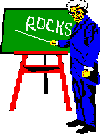Good Practices - Courses
Good Practices

Individual Course Resources
There are numerous examples of individual courses for which extensive Web resources have evolved over time.
- Geology and the Environment
Acadia University. In this course, nearly all of the resources are maintained by other individuals and groups. The instructor has spent the time to be aware of the variety of material available and constructed "outside reading lists" for her students.Underlying this sequence is a well thought out set of learning outcomes.
- Estuarine Oceanography
Brown University. "Examination of physical, chemical, and biological characteristics of estuaries and their
circulation processes and dynamics. Includes studying a local estuary using field
sampling, reduction and analysis of field data, and interpretation of processes;
investigation results prepared as a cooperative class report."
- Introduction to Geophysical Exploration,
Department of Geophysics, Colorado School of Mines, is another course which has evolved over time. In my opinion these resources could be used in a distance education mode. However, the developers have elected to use them as the background for the course and spend class time engaging their students in solving problems. If you are thinking about why you should spend time producing course resources for your students then you probably should read Program Objectives and The SEG Multi-Disciplinary Initiative: Teaching the Essence of Geophysics which was published in The Leading Edge in June, 1997. Examples of the interactive applets which are a key ingredient in these resources are given in the section on Analytical Resources.
- Physical Geology
Georgia Perimeter. This is a good example of a well developed course resource. The instructor has posted notes along with interactive home work exercises and Internet references.
- Body of the Earth
Northwestern University. For each class topic (for example, Size, Mass and Density of the Earth) there are classroom demonstrations, laboratory exercises, homework problems and concept explorations. In a similar vein is Small is Beautiful - Upgrading a beginning geophysics course. These are among the most useful course resources on the Internet.
- Earthquakes, Volcanoes and Other Hazards
Princeton. This is a well developed set of resources which have evolved during the past three years. The Image Catalog is tied to lecture topics.
- Structural Geology
St. Mary's University. "Structural geology is the study of deformation and its
effects within solid Earth. This page contains links to
information on Structural Geology, primarily for
students taking courses in Structural Geology and
Tectonics.
Like the Earth's lithosphere, this site is permanently
under construction: please be patient if not all the
links are connected yet."
- Natural Science - Geology
University of Arkon -- "Most of the information in this course will be presented
using the World Wide Web. Students can access the material from home,
work, or on campus. Computers are available in university labs or in the
Geology Resource Center"
- Geology 202 - Petrography
Department of Earth and Ocean Sciences at the University of British Columbia, is the first course with extensive Internet-based resources that I found when I started my search for how faculty were using the Internet. A lot of my thoughts and beliefs as to why I was preparing these resources evolved from this presentation. Note the presence of a communications center, a glossary, an image database and a minerals in thin section database. The home page is "clean" and easy to use. Keep in mind that what you see evolved over several years. Don't think that you have to wait until you have a full-blown site. In fact, it is probably better to start small and use the experiences of your audience to guide the development of the resources.
- Introduction to Geology
University of Cincinnati - "
This page is available to anyone who has access to the World Wide Web, but it is intended primarily for students
registered in Introduction to Geology (15-040-101, 102, 103) at the University of Cincinnati. This course is
intended for both majors and non-majors. Taken in its entirety, the course is designed to acquaint students with
the major concepts in geology and with the investigative processes through which geologic discoveries are made." The pre test is a good idea waiting to be copied!
- How Earth Works : The Dynamic Planet
University of Michigan - "Processes in our continuously evolving Earth have given rise to the formation of an
internally-layered planet with continents, oceans and an atmosphere. This continuing activity is
manifested by the destructive powers of such phenomena as earthquakes, tsunamis, volcanic
eruptions, mountain building, and plate motion. "
- Gems and Gem Minerals
U. Texas. "Welcome to the Fall '98 Gems and Gem Minerals class! From this home page you can navigate to course information, lecture handouts, on-line lecture notes and much more."
- Physical Geology
Physical Geology as offered as an OnLine Course at the University of Houston.
- Oceanography
University of Washington, School of Oceanography. Extensive resources for an upper level course in oceanography.
There are more than 1,400 course resources in the FileMaker Pro Database
January 15, 2001
Return to the Virtual Geosciences Professor's Good Practices Home Page
